|
Dr. Henry Genet Taylor |
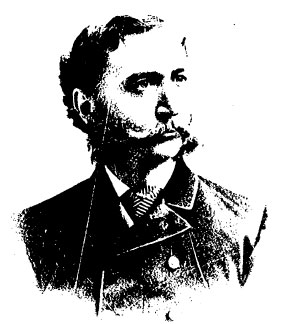
|
DR. HENRY GENET TAYLOR was born on July 6, 1837. He was a grandson of Citizen Genet, France's first ambassador to the United States, and a nephew of Governor DeWitt Clinton of New York. His father, Dr. Othniel Hart Taylor, was a distinguished physician who had a long career in Camden. After completing his medical studies at the University of Pennsylvania, Dr. Taylor opened an office in Camden NJ in 1860. When the Civil War broke out, Dr. Taylor soon was enlisted in the Eighth New Jersey Regiment. He rose to the post of Brigade Surgeon of the artillery of the III Corps, Army of the Potomac, and served under Major Generals Hooker, French, and Sickles. He left the |
|
Army in March of 1864, but remained connected with the military as an examiner of draftees and with the National Guard of New Jersey as late as 1887. Dr. Taylor was a founder of Camden's first hospital, the Camden Dispensary, He served as Physician-in-Chief at the Camden Home for Friendless Children, and was on the Board of Directors of Cooper Hospital from its founding through at least 1897. Dr. Taylor was on the original staff of Cooper Hospital when it was founded in 1884, and when it was dedicated on August 12, 1887. The four original attending physicians were Dr. Dillwyn Pancoast, Dr. H. Genet Taylor, Dr. Alexander M. Mecray, and Dr. William A. Davis. The surgeons were Doctors E.L.B. Godfrey, O.P. Cross, Dowling Benjamin and J.F. Walsh, with Dr. Joseph H. Willis as the original pathologist and Dr. Harry B. Jarrett serving as the first Resident Physician. In April of 1893 Dr. Taylor was elected President of the Board of Managers of the New Jersey Training School for Nurses. Dr. Taylor was a member and officer of many professional and fraternal organizations. He was a charter member of Trimble Lodge, No. 117 Free and Accepted Masons, and also was a member of the Camden County Historical Society. In 1885 Dr. Taylor had built a home on Cooper Street, designed by prominent Philadelphia architect Wilson Ayre, at 305-307 Cooper Street. This house, as part of the Cooper Street Historic District, was added in 1989 to the National Register of Historic Places. One of the most noted physicians in Camden in his day, Dr. Taylor cared for many prominent citizens, including Senator William Joyce Sewell. Dr. Henry Genet Taylor passed away early in 1916, survived by his wife, Helen and a son, Henry Genet Taylor Jr. The Taylor family remained at 305 Cooper Street in Camden as late as 1959. Virgil Willett was a longtime member of New jersey Lodge No. 1, Independent Order of Odd Fellows and of Camden Lodge, No. 1, Ancient Order of United Workmen. George Reeser Prowell wrote the following in his History of Camden County,New Jersey which was published in 1886: Ancient Order of United Workmen. The object of this order is to embrace and give equal protection to all classes and kinds of labor, mental and physical; to strive earnestly to improve the moral, intellectual and social condition of its members; to create a fund for the benefit of its members during sickness or other disability, and, in case of death, to pay a stipulated sum for each member, thus guaranteeing his family against want. Its jurisdictions are a Supreme Lodge, Grand and Subordinate Lodges. The Grand Lodge of Maryland, New Jersey and Delaware is thus officered: G. M. W., John J. Gallagher, of Wilmington, Del.; G. F., William H. Vermilye, Jersey City, N. J.; G. O., James A. Vansant, Camden, N. J.; G. G., John W. Diefendorf, Wilmington, Delaware; G. R., A. F. Colbert, Baltimore; G. Receiver, Myer Hirsch, Baltimore; G. M. E., G. S. Wilkins, M.D., Baltimore. Camden Lodge, No. 1. was chartered January 27, 1879, with these officers : Master Workman, Joseph R. Leaming; Foreman, Charles Markley; Overseer, George W. Coles; Recorder, Harry Ladow; Financier, William Thegen; Receiver, Albert P. Brown; Guide, William P. Partenheimer; Inside Watchman, Benjamin M. Denny; Outside Watchman, William Jones; Medical Examiner, H. Genet Taylor,M.D. These were also charter members, Moore Beideman, Robert L. Barber, John F. Benner, De Witt C. France, Joel H. Evaul, Henry S. Fortiner, George R. Fortiner, Howard L. Gandy,Merritt Horner, William Struthers, Benjamin G. Smith, William H. Stans bury, Marmaduke B. Taylor, Frank S. Wells, John S. Wells. The lodge has one hundred and forty-eight members, with these officers: Past Master Workman, J. C. Prickett; Master Workman,Virgil Willett; Foreman, J. H. Le Chard; Overseer, R. R. Lewellen; Receiver, W. R. Lun drum; Financial Secretary, Charles Markley; Recording Secretary, John Woltjen; Guide, J. S. Pike; Inside Watchman, John W. Clopper, Jr.; Outside Watchman, J. H. Evaul; Medical Examiner, E. R. Smiley, M.D. |
|

|
| Philadelphia Inquirer-April 20, 1871 |
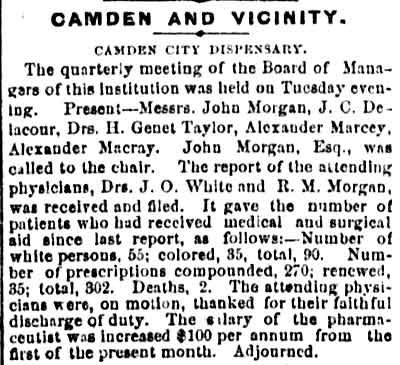
|
|
Dr.
H. Genet Taylor-Dr. Alexander Marcy-Dr. J.O. White Dr. Alexander Mecray-Dr. Randall M. Morgan John Morgan-Joseph C. Delacour |
|
Philadelphia Inquirer-April 16, 1884 |
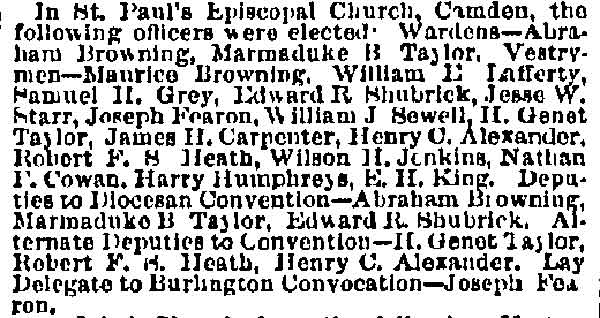
Abraham
Browning-Marmaduke B.
Taylor-Maurice
Browning
William Lafferty-Samuel H. Grey-Edward
Shubrick
Jesse W. Starr-Joseph
Fearon
William
Joyce
Sewell-
Dr. Henry Genet Taylor
James H. Carpenter-Henry
C.
Alexander-Robert F.S. Heath
Wilson H.
Jenkins-
Nathan Cowan-Harry Humphreys
E.H.
King-St.
Paul's Episcopal Church
|
BIOGRAPHICAL REVIEW-1897 |
|

|
|
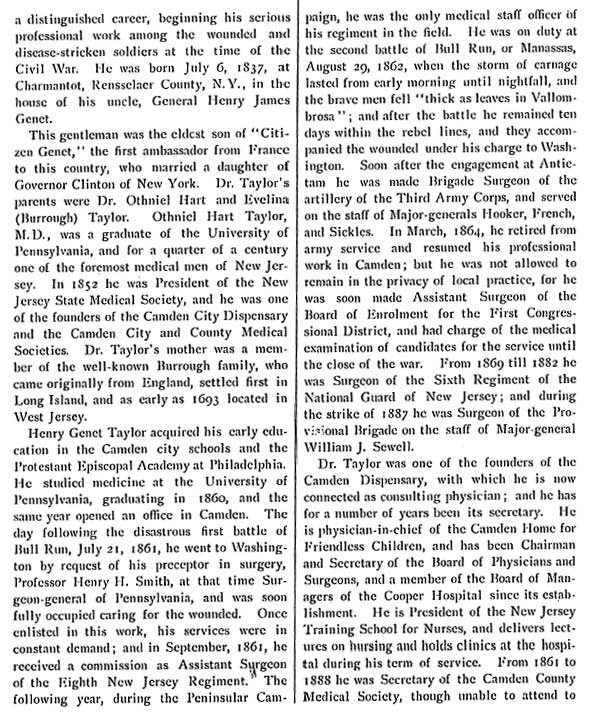
|
|
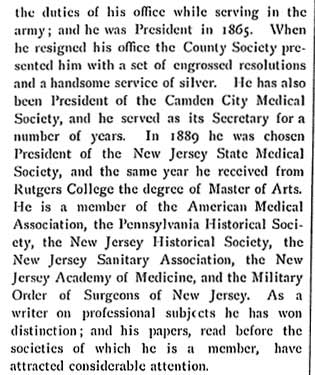
|
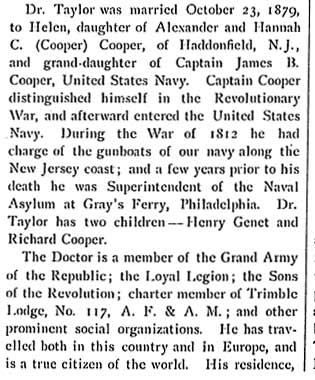
|
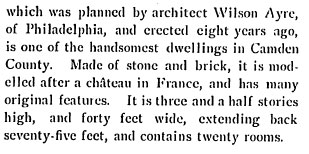
|
|
|
Philadelphia Inquirer-April 26, 1905 |
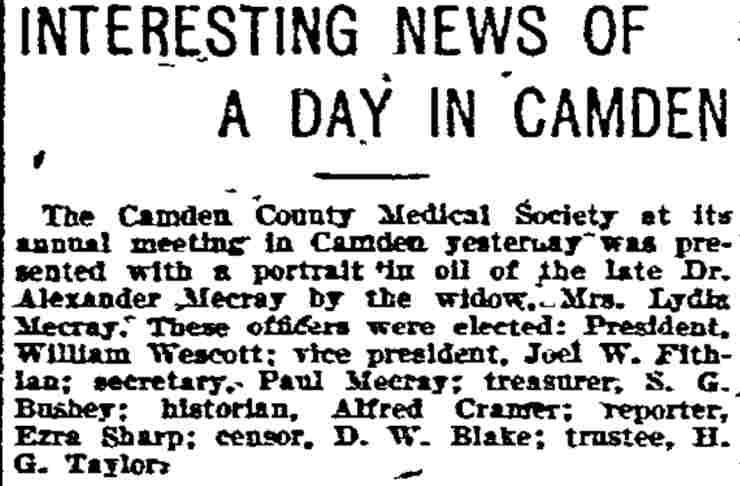
Dr. Alexander Mecray-Lydia Mecray-Dr. William A. Wescott
Dr.
Joel W. Fithian-Dr. Paul Mecray-Dr. Sylvan G. Bushey
Dr. Alfred Cramer Jr.-Dr. Ezra
Sharp
Dr.
Duncan W. Blake- Dr. Henry
Genet Taylor
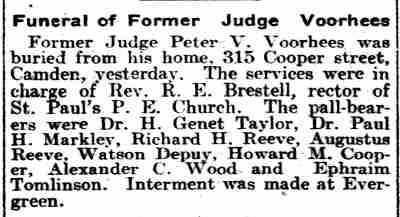
|
Philadelphia Inquirer
Dr. H.
Genet Taylor-Dr. Paul H.
Markley |
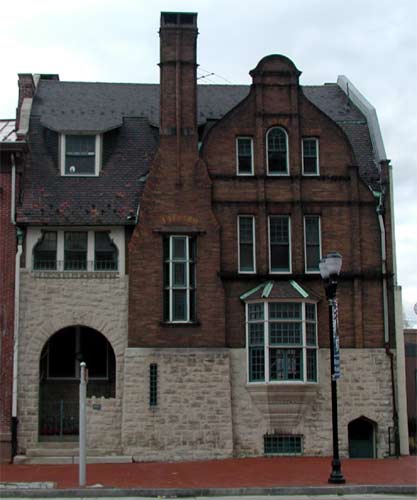
|
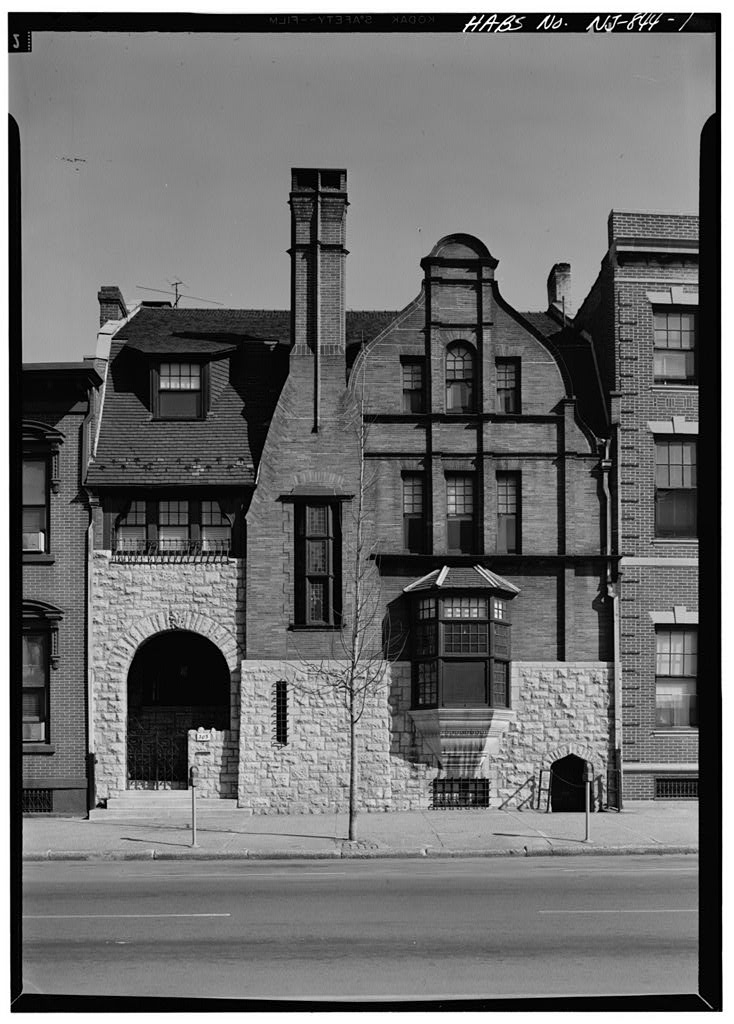
|
Dr. Henry Genet Taylor House at 305-307 Cooper Street |
|
Click
Here for 22 more images of the Dr. Henry Genet Taylor House |
|
|
Regimental History Eighth Infantry.--Cols., Adolphus J. Johnson, John Ramsey; Lieut.-Cols., Thomas L. Martin, Joseph Trawin, William Ward, John Willian, Henry Hartford; Majs., Peter M. Ryerson, William A. Henry, George Hoffman, Virgil M. Healey, Louis M. Morris. This regiment was organized under the provisions of an act of Congress, approved July 22, 1861, and was fully organized, officered and equipped by Sept. 14, at which time it was mustered into the service of the United States, for three years, at Camp Olden,Trenton. It left the state on Oct. 1, with 38 officers, 851 non-commissioned officers and privates, a total of 889.
Upon arrival at Washington it went into camp at Meridian
hill, and there remained until the early part of December, 1861, when it was ordered
to report to Gen. Joseph Hooker, near The regiment received its initiation into actual warfare at the battle of Williamsburg, where with the 6th and 7th it was sent into a wood in front of a line of field-works Among the killed in that battle was Maj. Ryerson, while among the wounded were a large number of officers, including Col. Johnson. Gen. Hooker,in his report of the battle of Fair Oaks, testified in the most emphatic terms to the gallantry of the brigade and added that the service assigned to the 7th and 8th in the rear was performed to his entire satisfaction. The loss of the regiment at Fair Oaks or Seven Pines was 1 killed and 6 wounded. In the engagement at Bristoe Station Lt. Col. Ward was wounded in the arm and side, and Capt. J. Tuite was killed. In the series of engagements ending at Chantilly on Sept. 1, 1862, the regiment lost 25 men.
In the formation of troops for the battle of
Chancellorsville, the New Jersey brigade, which at that time included the 2 nd N.
Y., 115 th Pa., 5 th, 6 th, 7 th and 8th N. J., under command of Gen. Mott, crossed
the Rappahannock on May 1. The 5th and 8th N. J. were detached to guard the
pontoons, while the others were picketed along the Rappahannock to its junction with
the Rapidan and thence along that river to connect with pickets thrown out by Carr's
1st N. Y. brigade. Mott received instructions directing Him to guard the ford,
Seeley's battery being placed at his disposal. At 6 o'clock on the morning of May 3,
the battle opened with skirmishing on the left, and it soon extended along the
entire front, accompanied by a hot artillery fire from the enemy, the first shot
from the latter's guns killing 2 men of the 8th. At one period of the engagement, a
section of artillery belonging to Dimmick's regular battery, 1 st artillery, being
in danger of capture, all the cannoneers and horses having been killed, Gen. Mott
dispatched Capt. Nichols with a detachment of the 8th to bring it off by hand. The
battery was rescued, the gallant heroes of the 8th, with the brave Capt. Nichols,
bringing the guns safely into the lines. On June 25, 1863, a large number of the 8th reenlisted in the field, for three years or during the war, and those who did not reenlist and whose term of service had expired were mustered out at Trenton, Sept. 21, 1864. On the Second Day of the Battle of Gettysburg(July 2, 1863) the 8th New Jersey Infantry was detached form its brigade and sent to the Rose Woods next to the Wheatfieldas some of the first troops to defend the area from the attacking Confederates.
Those who had reenlisted in 1863 who remained were
consolidated into the 8th battalion and so remained until Oct. 12, 1864, at which
time the 6th battalion was joined to it by transfer. The command then resumed its
regimental organization, which it continued until the close of the war, the regiment
being finally mustered out at Washington, July 17, 1865. The total strength of
the Source: The Union Army, vol. 3 Battles Fought Fought at Williamsburg, VA. Fought on 05 May 1862 at Williamsburg, VA. Fought on 01 June 1862 at Fair Oaks, VA. Fought on 16 June 1862 at Fair Oaks, VA. Fought on 28 June 1862 at Hospital, Fair Oaks, VA. Fought on 28 June 1862 at White Oak Swamp, VA. Fought on 29 June 1862 at Fair Oaks, VA. Fought on 27 August 1862 at Bristoe Station, VA. Fought on 29 August 1862 at 2nd Bull Run, VA. Fought on 30 August 1862 at 2nd Bull Run, VA. Fought on 03 May 1863 at Chancellorsville,VA. Fought on 02 July 1863 at Gettysburg, PA. |
RETURN TO CAMDEN'S INTERESTING PEOPLE PAGE